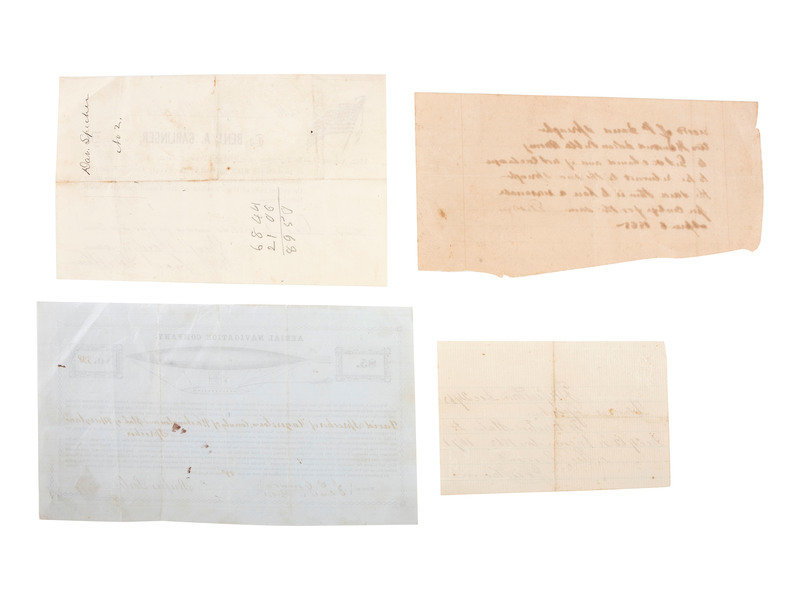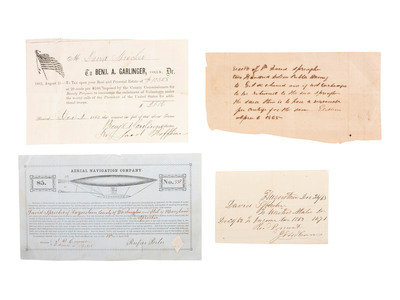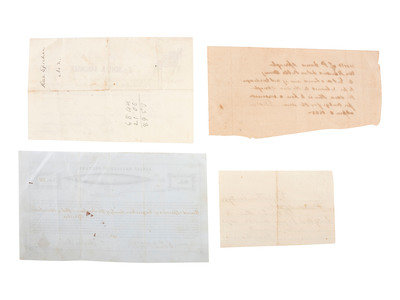Condition Report
Contact Information
Auction Specialist
Lot 661
[TRANSPORTATION - AVIATION]. A group of 4 items associated with transportation, including a stock certificate of the Aerial Navigation Company, 1852.
Sale 1005 - American Historical Ephemera & Photography
Lots Open
Mar 1, 2022
Lots Close
Mar 8, 2022
Timed Online / Cincinnati
Own a similar item?
Estimate
$200 -
400
Price Realized
$156
Sold prices are inclusive of Buyer’s Premium
Lot Description
[TRANSPORTATION - AVIATION]. A group of 4 items associated with transportation, including a stock certificate of the Aerial Navigation Company, 1852.
Stock certificate for the Aerial Navigation Company, $5, No. 398. Dated 29 April 1852. Signed by Rufus Porter. 4-3/4 x 8 in. with vignette of one of Porter’s “aeroports,” a bi-pointed balloon with a cabin suspended beneath. This certificate made out to David Sprecher of Hagerstown, Maryland.
The other items in the lot are also associated with Sprecher: one is a receipt (3-1/4 x 5 in.) for his 1862 income tax, Dec. 24, 1863; there is a second tax receipt (4.5 x 7 in.), 2 Dec. 1862; the last a receipt (approx. 3-1/2 X 7-1/2 in.) for $200 In “rebel money” to be exchanged. (If unable to exchange, it was to be returned to Sprecher.) April 6, 1865 (just 3 days before Lee’s surrender).
Rufus Porter (1792-1884) was one of those individuals with wide-ranging curiosities in art, science and communications, but who has been mostly forgotten by history, largely because he was unable to bring many of his inventions into production. Porter was an artist, who painted everything from miniature portraits to wall murals. His work was the subject of an exhibit at Bowdoin College, Rufus Porter’s Curious World: Art and Invention in America, 1815-1860, which was scheduled from Dec. 12, 2019 to May 31, 2020.
Porter was one of the founders of Scientific American, invented mechanical devices, wrote practical manuals and “designed an airship to fly Gold Rush prospectors from New York to California in three days. Porter believed these advancements would create a better world.” ( https://www.bowdoin.edu/art-museum/pdf/rufus-porter-exhibition-labels-bowdoin.pdf) Many of his ideas were put to the public in Scientific American. He first proposed a “Traveling Balloon” in 1834 in a letter to the editors of Mechanics’ Magazine. In 1849 he published his magnum opus on aerial navigation, in part to stimulate sales of stocks to finance his flying steamers. As the certificate says, he proposed two: “…the first to be one hundred and fifty feet in length, and capable of carrying five persons, and the other to be seven hundred feet long, and capable of carrying one hundred and fifty persons, safely, at the rate of ninety miles per hour;…”
The exhibit also featured a number of items from William Markoe, who turned out to be one of Porter’s most dependable patrons (although eventually Markoe realized that he was unlikely to see any returns on money given to Porter). (The stock certificate in the Bowdoin exhibit was one of Markoe’s.) However, in 1857, Markoe made an ascent in a craft of his own design, covering 45 miles in an hour and a half. In 1849 Markoe was ordained as an Episcopal minister and moved to the Midwest. In a letter the following year after passage of the Fugitive Slave Act, Porter promised Markoe that his aeroport would not be used to hunt down fugitive slaves for return to the South.
One invention that was a success, was not produced by Porter. Porter produced a percussion-cap revolving rifle in 1826. He did not patent the design, but sold its production rights ten years later to Samuel Colt for $100. It became one of Colt’s most successful inventions of the 19th Century. In any number of paintings and texts about men who changed civilization, Rufus Porter is not included. Yet two of his friends, Samuel Colt and Samuel F.B. Morse, are included, even though a number of inventions both men became known for were Porter’s.



